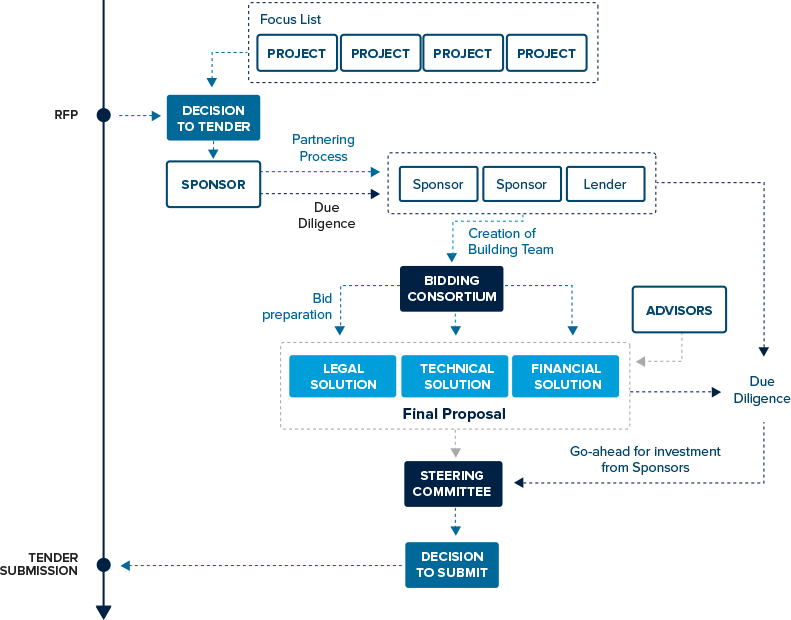Following on from a successful PPP project screening, and once partnerships have been formed between like-minded organizations in the consortium (see section 6.4), the two main activities that the consortium will carry out are preparing the response to the procuring authority’s RFP and making the investment decision about whether to submit a consortium response to it.
Section 6.7 below sets out all the key activities that need to be completed by the consortium in order for a RFP response to be completed and submitted.
Making the investment decision about whether to submit a RFP requires each individual member of the consortium (each sponsor, see section 6.4.1), and the consortium as a whole to acquire a deeper understanding of the main risks associated with the PPP project. Specifically, there needs to be consideration of how such risks could be allocated and managed by consortium members if they decide to submit a RFP[2]. Accordingly, each consortium member will carry out a more in-depth assessment of the PPP project risks because: (i) each sponsor will need to assess whether its organization should make a decision to proceed with the PPP project; and (ii) all sponsors, acting together as the consortium, will need to take a collective consortium decision about whether to proceed with responding to the RFP.
Both the sponsors and the consortium will require a full analysis of the commercial risks associated with the procuring authority’s PPP project, including an appraisal of any threats to the forecasted project revenues. Additionally, consideration will be given to any regional or country risks.
Local intelligence about PPP project specific issues, such as the stability of the local environment where the PPP project will be implemented and the preparedness of the procuring authority to run its PPP project tender, will also be important to know. These factors will influence the sponsors’ and the consortium’s decisions. Politically unstable environments (for example, where are elections due) create a risk that a new government might not support the procuring authority in its PPP project proposal. This will cause concern. Similarly, if the procuring authority lacks sufficient personnel or is not adequately prepared and organized to run its PPP project tender, then this too will be of concern to sponsors and the consortium.
Concern arises because if any of the risks materialize, the successful operation of the procuring authority’s PPP project tender could be jeopardized at any stage and, specifically, before the final award of the PPP project. From the consortium’s and each individual sponsor’s perspective, neither will want to expend its time, money, and energy bidding for the PPP project if there is a significant risk that it might be aborted midway through its procurement. It is therefore good practice for the procuring authority to provide evidence of governmental support for its PPP project, and to give evidence to bidders that it is suitably prepared to run the PPP project tender.
An additional area of concern for sponsors and the consortium is the PPP project’s procurement timetable. Sponsors and the consortium will require an assurance that the suggested procuring authority’s procurement timetable is achievable. Project sponsors and the consortium will dislike taking part in a bidding process that does not proceed according to a robust and appropriate timetable. Frequent timetable changes will erode their confidence in the PPP project unless there are objectively good reasons for changes, or the changes are requested by a private party.
The sponsors and the consortium also frequently require an assurance regarding the procuring authority’s preparedness[3] to run its PPP project tender, the quality of the PPP project’s contractual documents, and the support the PPP project has from within government. Such assurances will provide some comfort that the risk of a PPP project being aborted has been mitigated.
This analysis will normally be carried out using the sponsors’ in-house resources, typically their business development team or their investment team. When carrying out this exercise it is important that the sponsors have broad experience in identifying and managing risks similar to those likely to emerge in the PPP project. In this context, the sponsors’ previous experience will mean that they will know what points/issues are of concern when carrying out the analysis. In some instances, the sponsors might also hire external/independent experts to help with this task.
On completion of its analysis, each sponsor will let its fellow sponsors know of its decision to participate and continue its involvement in the bidding process. These decisions will normally be discussed during regular consortium meetings known as steering group meetings – see section 6.4.3. Further, the decision of each sponsor will be taken into account when the consortium makes its decision on whether to submit a RFP response. See figure 6A.4.
FIGURE 6A.4: Bid Preparation and the Decision to Submit a Response to the RFP

Note: RFP= Request for Proposal.
[2] See McKinsey & Company, A Risk-Management Approach to a Successful Infrastructure Project. Initiation, Financing and Execution (2013) for details on how to establish an integrated enterprise-risk-management (ERM) approach.
[3] There is evidence that lack of preparedness may facilitate opportunistic negotiations over aspects of the PPP project. See Engel, Fischer and Galetovic, Public-Private Partnerships: When and How, 2000.


Add a comment